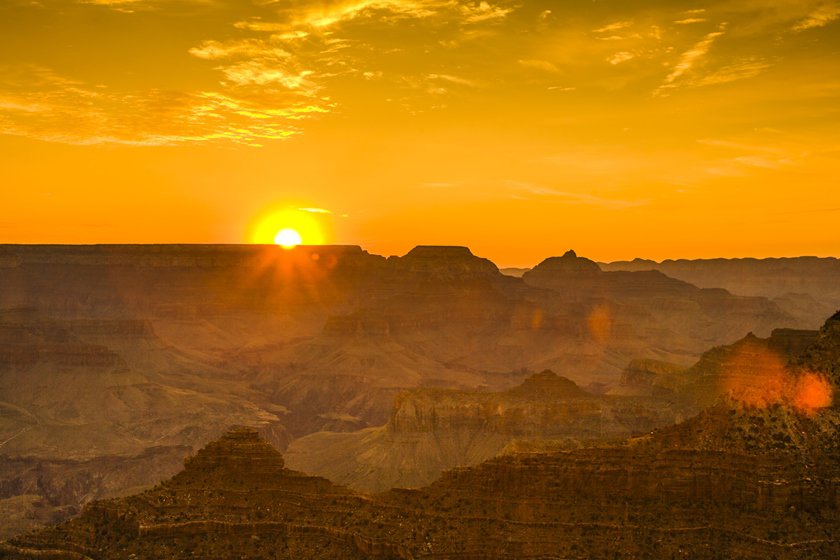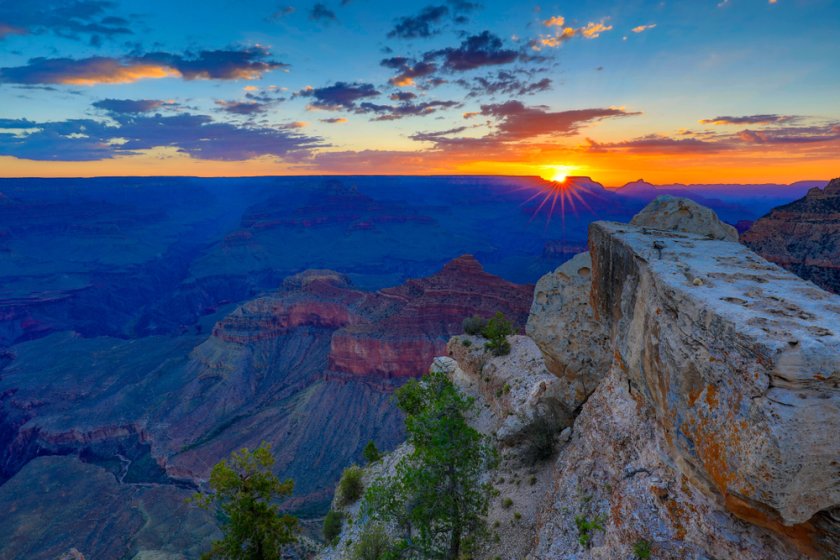Sunrise and sunset, as you know, are the most romantic moments of the day. When the sun is low on the horizon, the landscape lights up with a thousand shades of red, orange, pink. Whether you are a professional photographer looking for the best exposure, or a couple who want to take a souvenir photo at the perfect moment, you will need to find the precise point where to place your camera tripod.
So, what are the best spots to watch the Grand Canyon at sunrise and sunset? In this article, I will try to give you some tips so that you can take pictures that capture forever your experience in one of the natural symbols of the United States.
Contents
Sunrise and Sunset Times and Time Zone
First, it is important to know when the sun rises and when it sets on the Grand Canyon. Remember that we are in Arizona and, therefore, the official time zone is Mountain Standard Time. Arizona, however, is the only state in the U.S. (besides Hawaii) that does not apply daylight saving time in the summer. If you’re planning a road trip between Utah, Arizona and the Navajo Nation (where Monument Valley is located), you should pay close attention to time zone changes.
In fact, you may plan to arrive at a viewpoint in time for sunset and then realize at the last moment that your calculations were off by one hour. I suggest you also read this article dedicated to the time zones of this area.
Every day the time the sun rises and sets varies, increasing or decreasing gradually by a few minutes in each season. You just need to search online for the exact time of the sunrise and sunset on a specific day, but just so that you have at least a rough idea, which is useful in planning your trip, here is a list of the approximate times for each month of the year.
- January: Sunrise 7:30 am, sunset 5:30 pm
- February: Sunrise 7:20 am, sunset 6:00 pm
- March: Sunrise 6:45 am, sunset 6:30 pm
- April: Sunrise 6:05 am, sunset 6:55 pm
- May: Sunrise 5:30 am, sunset 7:20 pm
- June: Sunrise 5:10 am, sunset 7:45 pm
- July: Sunrise 5:20 am, sunset 7:45 pm
- August: Sunrise 5:40 am, sunset 7:25 pm
- September: Sunrise 6:05 am, sunset 6:45 pm
- October: Sunrise 6:30 am, sunset 5:55 pm
- November: Sunrise 7:00 am, sunset 5:25 pm
- December: Sunrise 6:30 am, sunset 5:15 pm
I also want to point out one thing that is often overlooked that is fundamental, which is that the sunrise and sunset times that you find online indicate the time when the sun has completely risen or has completely set. So in order not to miss the moment when the colors of the sky gradually change as the sun goes up or down, always make sure you arrive well in advance.
Arrive half an hour before sunrise, so you can fully appreciate the transition from the darkness of night to sunrise. It is better to arrive an hour or an hour and a half before sunset, especially if you are an experienced photographer, so that you can capture the colors as they change.
Grand Canyon: Sunrise or Sunset? Which One to Choose and Why
People often ask themselves: is it better to go to a particular overlook at the Grand Canyon at sunrise or sunset? In some cases, it is quite simple to answer this question. Depending on whether a viewpoint is facing east or west, or on the layout, the beginning or the end of the day may be the more favorable time for the best photos. In the case of the Grand Canyon, the answer is not so obvious. We are talking about a very large geographical area, divided into three large areas. The differences between the North Rim, the West Rim and the more mainstream South Rim are remarkable.
Even considering only the southern part of the park, which is the most frequented, there are numerous panoramic viewpoints facing different directions. Many of the positions from which it is possible to overlook the canyon are facing north and the panoramas, which make the views excellent both in the morning and in the evening, so that the sun is never completely in your face or behind you. Some viewpoints, however, are better suited for one or the other time of day and in the next paragraph, we will see them in detail. But let’s first look at basic principles.
Generally speaking, the sky at dawn is clearer, unless there were strong winds during the night that raised large amounts of dust in the air. Therefore at dawn, there is a wider view. At the same time, the more frequent light haze during sunset can increase the variety of colors. In the middle of summer, thunderstorms often occur late in the afternoon. This is another factor to keep in mind. Always check the forecast, because being at a viewpoint when there is thunder and lightning is neither pleasant nor safe.
Do not underestimate the number of visitors. During the summer, the influx of tourists to the Grand Canyon is considerable. One of the most popular times to visit the Grand Canyon is at sunset. In the summer, the park is almost always crowded at sunset. If you are looking for peace and quiet to take your photos or want to make sure you enjoy the moment without distractions around you, choose the sunrise instead of the sunset. Most tourists do not wake up early, or at least not early enough to reach the central areas of the park before sunrise. So in the summer, if you want to have the best chance to be alone at sunrise, set the alarm very early in the morning. Your small effort will be rewarded by the view.
Of course, this is easier if you stay overnight in the park. Check out our article on where you can stay at the Grand Canyon to get an idea of the options available. You can also book a 2-day tour from Las Vegas including an overnight stay in the Grand Canyon area and you can choose to see either the sunrise or sunset.
Grand Canyon Tour with an overnight stay
Best Spots to Watch the Sunset
Hopi Point is perhaps the most crowded place at sunset, and it is no surprise. From here, the view is perfect when the sun goes down behind the edges of the canyon. If you plan to go there in the summer, make sure you leave well in advance.
Other viewpoints that are just as beautiful are Mohave Point and Pima Point. In my opinion, the view here can be considered even better than at Hopi Point, because you will have a clear view of the Colorado River below you. Finally, if you drive along Desert View Drive, you will find some overlooks with wide views, like Navajo and Desert View, which makes them ideal for sunset and sunrise.
You may also choose to take a jeep tour to make sure you don’t miss the sunset.
Best Places to Watch the Sunrise
Sunset is more popular, but sunrise is for connoisseurs. Even at the viewpoints mentioned above, you can enjoy a wonderful view at sunrise. In particular, as I mentioned, along Desert View Drive the views of Navajo and Desert View are wide enough to be optimal for both times of the day. But if you want to take some memorable photos of the sunrise, definitely choose Mather Point or Yaki Point.
How to Reach the Best Panoramic Viewpoints
It would be almost impossible to list all the places overlooking the Grand Canyon in a single article. I will therefore refer exclusively to those places with the best views for watching the sunrise and sunset, which are also easily accessible from the Grand Canyon Village. In some cases, a car (or rental car) is required, but some viewpoints can be easily accessed (even early in the morning and late in the evening) by shuttles (read our guide to getting around the Grand Canyon for more information).
- Kaibab Rim: next to the South Kaibab Trailhead, you will find one of the most frequented viewpoints throughout the day that can be reached by taking public transportation. To get here, you can take the orange line from the visitor center. The orange line also stops at Yaki Point, Pipe Creek Vista and Mather point.
- Hermit Road: The red line stops at 9 viewpoints and the main ones are Maricopa, Powell, Hopi, Mohave and Pima Points. Please note that this bus only runs from March 1st to November 30th. Unlike the orange line, during the period that the red line is active, the shuttle is the only way you are allowed to get to the viewpoints along the line. In the winter, unless the roads are closed due to snow, you can reach these viewpoints by car.
- Desert View Drive. If you go east of the Visitor center, you can drive the entire Desert View Drive, the scenic road that runs parallel to the river and allows you to reach some of the most spectacular views of the canyon, such as the Duck on a Rock Viewpoint, Grandview Point and the Desert View Watchtower. In this case, however, there are no shuttles specifically for Desert View Drive and you will have to use the car.
In the summer, especially if you want to see the sunset, I suggest you take advantage of the shuttles even where they are not mandatory. The shuttles are active starting approximately one hour before sunrise to one hour after sunset. This saves you the trouble of finding parking. Parking spaces are limited and while it may be easy to find a place at dawn, the same is not true at sunset.
Grand Canyon North Rim and West Rim
Compared to South Rim, the other two sectors of the park are less frequented, but they also have panoramic viewpoints, some of which are excellent for viewing the sunrise and sunset. As for the North Rim, first of all, you should keep in mind that it can only be visited from May 15 to November 30 and you need a car to get around, since there are no shuttles or other public transportation. If you drive along the North Rim Scenic Drive, you will find numerous observation points, but the best for sunrise and sunset (both) is undoubtedly Cape Royal. From here, the bend in the Colorado River is framed by Angels Window and you can also see the Desert View Tower on the South Rim.
What about the West Rim? Unfortunately, you will not be able to see the sunrise because it opens at 7:00 am. However, since it closes at 7:00 pm, this means that you can enjoy the sunset from the Skywalk most of the year. One suggestion is to take an organized tour at this time of day.





